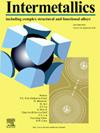组织演化对y2o3 -轴承合金高温力学性能和蠕变行为的影响
IF 4.8
2区 材料科学
Q2 CHEMISTRY, PHYSICAL
引用次数: 0
摘要
在本研究中,采用不同的热处理工艺来调节块状γ相与α2/γ片层的比例,创造有利于Y2O3纳米颗粒析出的条件。目的是研究组织演变对Ti-48Al-2Cr-2Nb-0.05Y2O3合金高温力学性能和蠕变行为的影响。随着保温温度从1200℃升高到1350℃,块状γ相的含量从61.49%降低到1.12%,形成近双相(NDP)、双相(DP)、近片层(NL)和全片层(FL)组织。升高的温度条件和增加的晶体缺陷共同促进了Y2O3纳米颗粒的析出,导致FL微观结构中纳米级增强的数量最多。随着热处理样品转换从民主党FL微结构,极限抗拉强度测试在800°C从384 MPa增加到668 MPa,而蠕变寿命测试在800°C下从10.8 h 325 MPa提高到138.2 h。伸长和蠕变应变最初增加然后减少,与热处理示例展示一个问组织展示最好的高温伸长21.48%,最高蠕变应变的19.55%。在NL组织中观察到的良好的塑性和变形能力可归因于片层组织及其周围块状γ相的协同变形。由于大量的纳米级Y2O3析出和最高含量的片层集落对位错运动起到了有效的钉住作用,从而产生了协同强化效应,使得FL显微组织具有优异的高温强度和抗蠕变性能。与常用的增强材料相比,双尺度Y2O3颗粒增强的热处理TiAl合金具有显著的高温性能,有望进一步提高TiAl合金的使用温度,扩大其在高温下的应用范围。本文章由计算机程序翻译,如有差异,请以英文原文为准。
The effect of microstructure evolution on the high-temperature mechanical properties and creep behavior of Y2O3-bearing alloy
In this study, various heat treatment processes were employed to adjust the ratio of blocky γ phase to α2/γ lamellae and to create conditions conducive to the precipitation of Y2O3 nanoparticles. The aim was to investigate the influence of microstructure evolution on the high-temperature mechanical properties and creep behavior of the Ti-48Al-2Cr-2Nb-0.05Y2O3 alloy. As the holding temperature increases from 1200 °C to 1350 °C, the content of the blocky γ phase decreases from 61.49 % to 1.12 %, resulting in the formation of nearly duplex (NDP) microstructure, duplex (DP) microstructure, nearly lamellar (NL) microstructure, and fully lamellar (FL) microstructure. The combination of elevated temperature conditions and increased crystal defects promotes the precipitation of Y2O3 nanoparticles, leading to the highest number of nanoscale reinforcements within the FL microstructure. As the heat-treated sample transitions from the NDP to FL microstructure, the ultimate tensile strength tested at 800 °C increases from 384 MPa to 668 MPa, while the creep life tested at 800 °C under 325 MPa improves from 10.8 h to 138.2 h. The elongation and creep strain initially increase and then decrease, with the heat-treated sample exhibiting an NL microstructure demonstrating the best high-temperature elongation of 21.48 % and the highest creep strain of 19.55 %. The favorable ductility and deformation capacity observed in the NL microstructure can be attributed to the cooperative deformation of the lamellar structure and its surrounding blocky γ phase. The excellent high-temperature strength and creep resistance of the FL microstructure result from the synergistic strengthening effect arising from a greater number of nanoscale Y2O3 precipitates and the highest content of lamellar colonies, which provide an effective pinning effect on dislocation movement. In comparison to commonly used reinforcements, the heat-treated TiAl alloys reinforced with dual-scale Y2O3 particles exhibit remarkable high-temperature properties, which are anticipated to further enhance the service temperature of TiAl alloys and expand their application at elevated temperatures.
求助全文
通过发布文献求助,成功后即可免费获取论文全文。
去求助
来源期刊

Intermetallics
工程技术-材料科学:综合
CiteScore
7.80
自引率
9.10%
发文量
291
审稿时长
37 days
期刊介绍:
This journal is a platform for publishing innovative research and overviews for advancing our understanding of the structure, property, and functionality of complex metallic alloys, including intermetallics, metallic glasses, and high entropy alloys.
The journal reports the science and engineering of metallic materials in the following aspects:
Theories and experiments which address the relationship between property and structure in all length scales.
Physical modeling and numerical simulations which provide a comprehensive understanding of experimental observations.
Stimulated methodologies to characterize the structure and chemistry of materials that correlate the properties.
Technological applications resulting from the understanding of property-structure relationship in materials.
Novel and cutting-edge results warranting rapid communication.
The journal also publishes special issues on selected topics and overviews by invitation only.
 求助内容:
求助内容: 应助结果提醒方式:
应助结果提醒方式:


